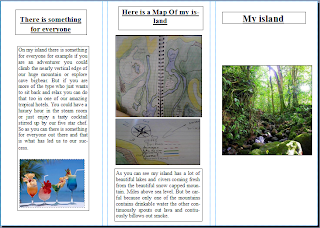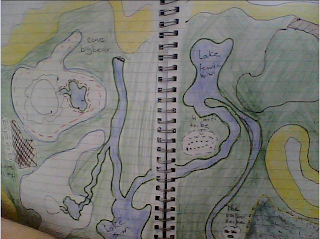During the Oct-Nov period my class and I have been creating our own island. We needed to use all of the things that we learn't about in Humanities class such as: Compass Rose, Inset Map, Legend, Scale, Stars for cities, and of course we also needed to use logic and everything needed to make sense. I really liked this project mainly because we got to draw our own maps but also because I think it was a good way to revise everything that we have learnt in Humanities. When we made our island it had to have all of these things the agriculture, a number system, a letter system, money, a flag, a government, imports and exports and history. So as you can see I found this project very educational and fun to do.
Hello Everybody!
Hi and welcome to my Humanities blog. Here is where I will be putting all of my humanities work throughout the 2011-2012 school year at ISB (the International School of Belgrade). I hope you will enjoy and please follow!
Monday, November 22, 2010
Thursday, November 18, 2010
Tuesday, November 16, 2010
My Island
Main info: My island is located in the north Atlantic ocean. It is inhabited by primitive savage canibals who like to be left alone, but that does not affect the tourist industry because the tourists stay in expencive hotels miles away from the savages. The island is close to the equator and that is the reason for the tropical rain forest. It is a very beautiful island with many animals and plants unique to the island like the Waka-waka which looks like a mole but instead of digging into the ground it digs into trees and feeds on the sugary sap.
History: In 1890 a new island was found by Cpt. Sweep, who was sailing the seas in search of a lost sailor and he saw the island. when he arrived on the island him and his crew found the dead body of the man who they were looking for. Savages! One of them called out. The savages jumped out of the shadows and launched an attack on the European sailors. The sailors won because they had rifles and cannons on the ship. The sailors drove the savages back into the middle and opposite end of the island.
The captain Sweep named the island Leregald after the last name of his wife. They formed tribes and lived happily undisturbed by the growing European tourist business. And since 1890 the European tourist business has been going very well. Over time the savages learnt some tricks from the Europeans like how to build mines and make money and what counting does.
Economy: This island has many exports of delicious fruits like the Hik -Hik fruit which it a cross between the date and a mango. It also has some exports of the savage things like shrunken heads and Waka- Waka claw necklaces. They also sell tribal charms and special types of tobacco. Their money is made of tin and they carve the symbols or numbers on it by carving a big oven out of rock heating the piece of tin up in a big fire and then shaping it and carving out the symbols with with several differently shaped stones each stone with it's own role.
Numbers: 1= z and 2= z with a line going through and so on until seven which is I and then ten is +.
Languge: Is a mixture of sounds and hand gestures the actual words sound like animal cries and birds (we are still working on trying to understand it).
Education: The savages are not very interested in education but they do teach the children some things depending whether they are male or female they learn different things. For example male children need to learn how to be warriors whereas female children need to learn how to sew and make medicines out of herbs and sacred plants.
Physical features: This island is a very popular island for tourists because it has a lot of amazing features like cloud top mountain or cave Big- Bear and even flat cliff, (one of the biggest ones in the world) so as you can see the island of Leregald is a very amazing place to go.
History: In 1890 a new island was found by Cpt. Sweep, who was sailing the seas in search of a lost sailor and he saw the island. when he arrived on the island him and his crew found the dead body of the man who they were looking for. Savages! One of them called out. The savages jumped out of the shadows and launched an attack on the European sailors. The sailors won because they had rifles and cannons on the ship. The sailors drove the savages back into the middle and opposite end of the island.
The captain Sweep named the island Leregald after the last name of his wife. They formed tribes and lived happily undisturbed by the growing European tourist business. And since 1890 the European tourist business has been going very well. Over time the savages learnt some tricks from the Europeans like how to build mines and make money and what counting does.
Economy: This island has many exports of delicious fruits like the Hik -Hik fruit which it a cross between the date and a mango. It also has some exports of the savage things like shrunken heads and Waka- Waka claw necklaces. They also sell tribal charms and special types of tobacco. Their money is made of tin and they carve the symbols or numbers on it by carving a big oven out of rock heating the piece of tin up in a big fire and then shaping it and carving out the symbols with with several differently shaped stones each stone with it's own role.
Numbers: 1= z and 2= z with a line going through and so on until seven which is I and then ten is +.
Languge: Is a mixture of sounds and hand gestures the actual words sound like animal cries and birds (we are still working on trying to understand it).
Education: The savages are not very interested in education but they do teach the children some things depending whether they are male or female they learn different things. For example male children need to learn how to be warriors whereas female children need to learn how to sew and make medicines out of herbs and sacred plants.
Physical features: This island is a very popular island for tourists because it has a lot of amazing features like cloud top mountain or cave Big- Bear and even flat cliff, (one of the biggest ones in the world) so as you can see the island of Leregald is a very amazing place to go.
Thursday, November 4, 2010
Tuesday, November 2, 2010
Alfies' Notes on Themes and Essential Elements of Geography
- Absolute Location:The exact location of something often written in latitude and longitude.
- Relative Location: The position of one place compared to another place.
- Region: An area of Earth’s surface with one or more shared characteristics.
- Movement: People and ideas moving from place to place.
- Diffusion: The movement of ideas or behaviors from one cultural region to another.
- The study of geography is organized into five important themes, or topics of study.
- Another way geography is organised is by its essential elements, or most important parts.
Section 2 review
- By studying why things are where they are.
- The weather and natural disasters. The weather can erode rock to make cliffs. Earthquakes can also form mountains.
- Humans develop and change the world for their benefit and humans also use up Earths' resources.
Subscribe to:
Posts (Atom)




